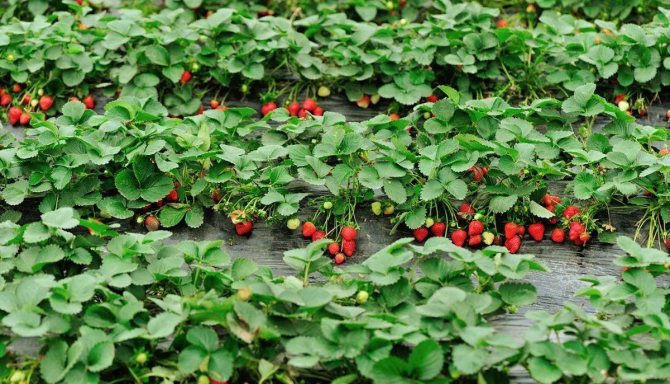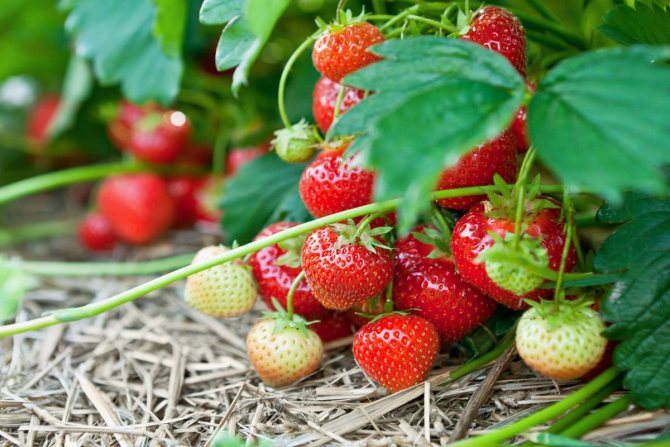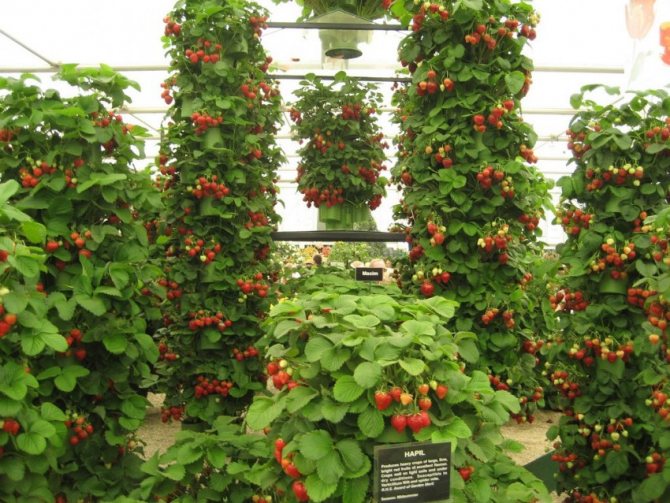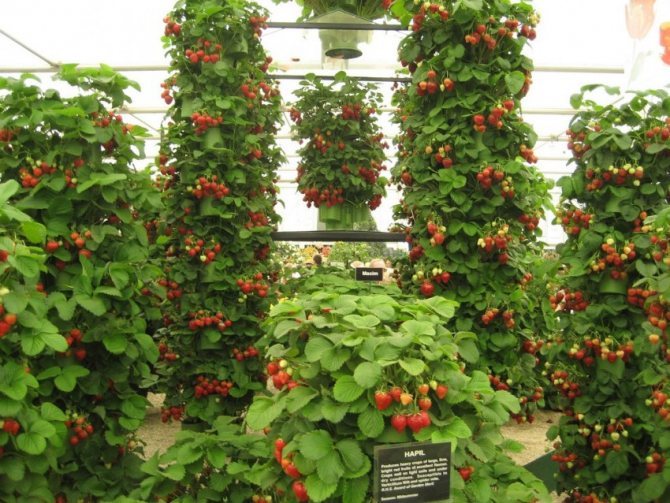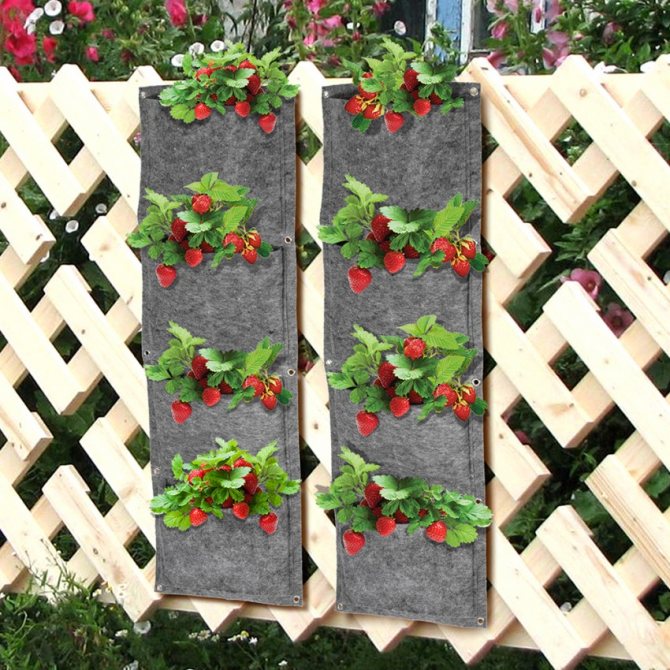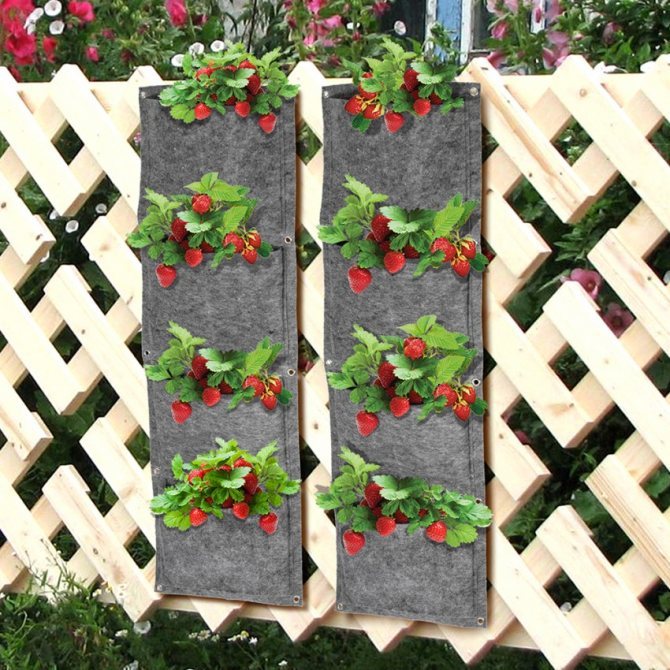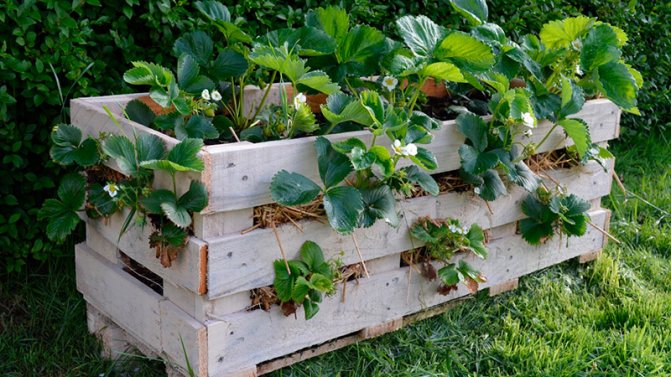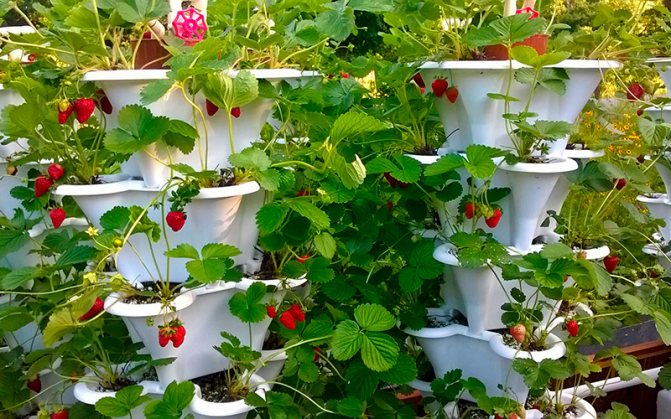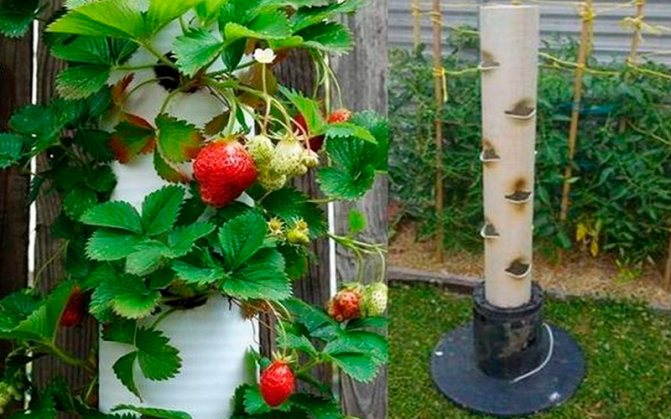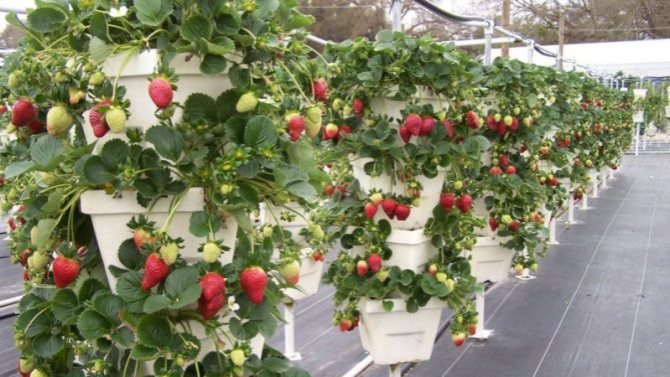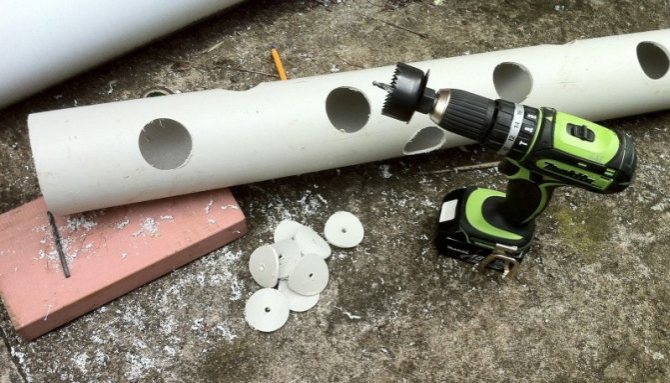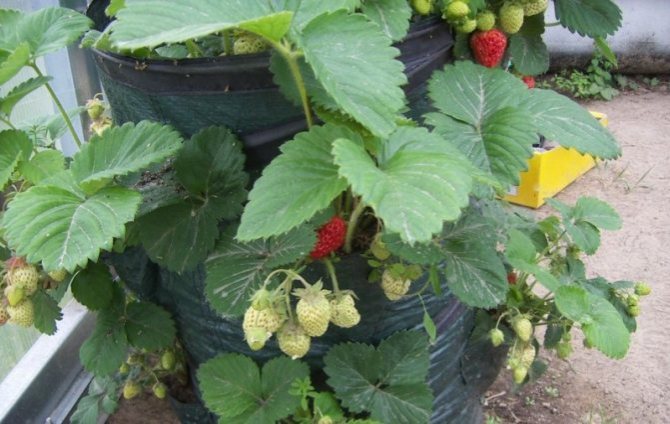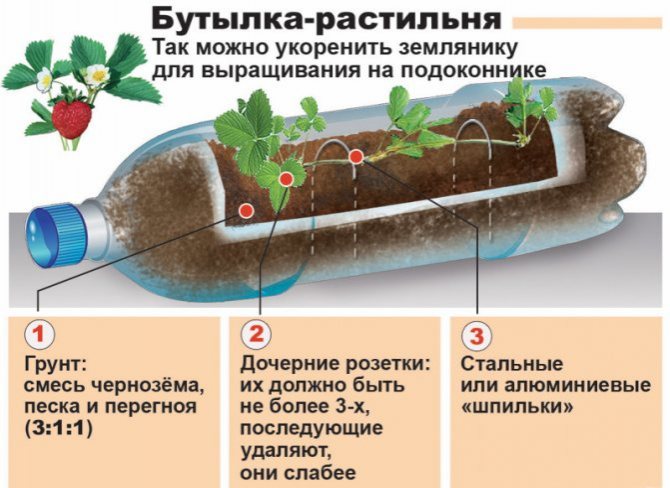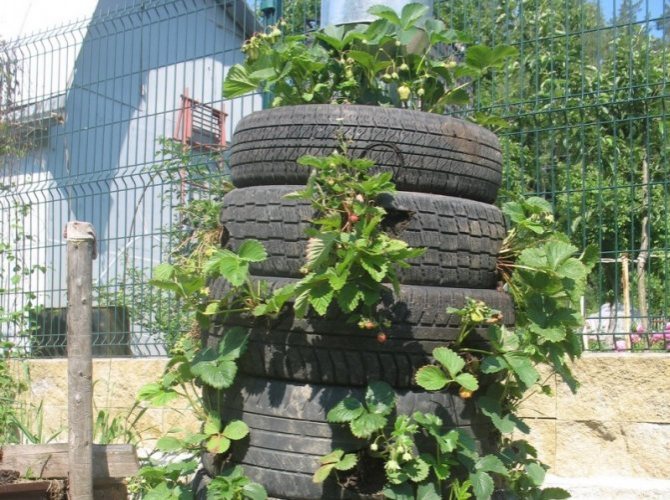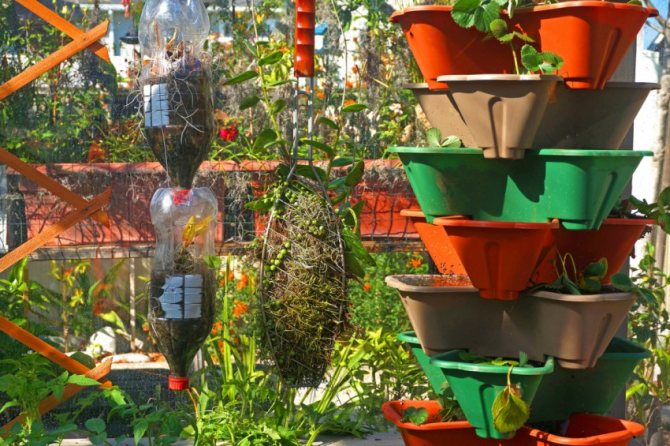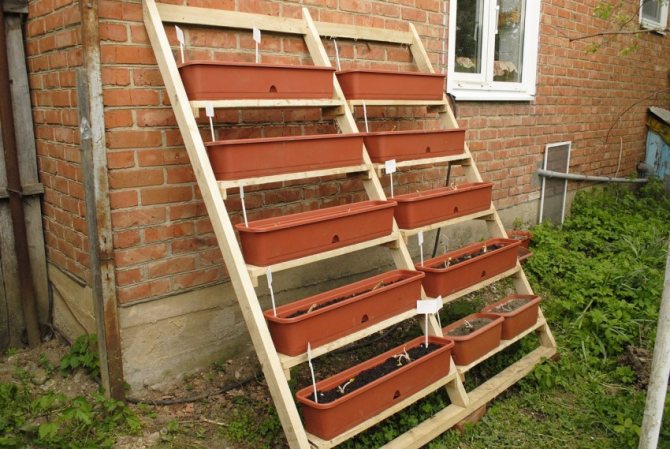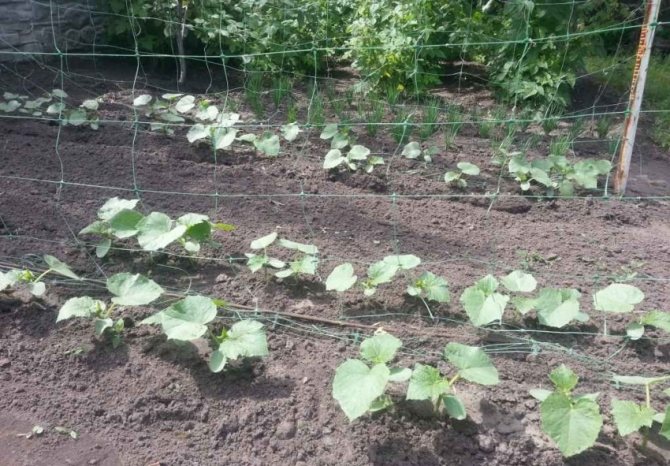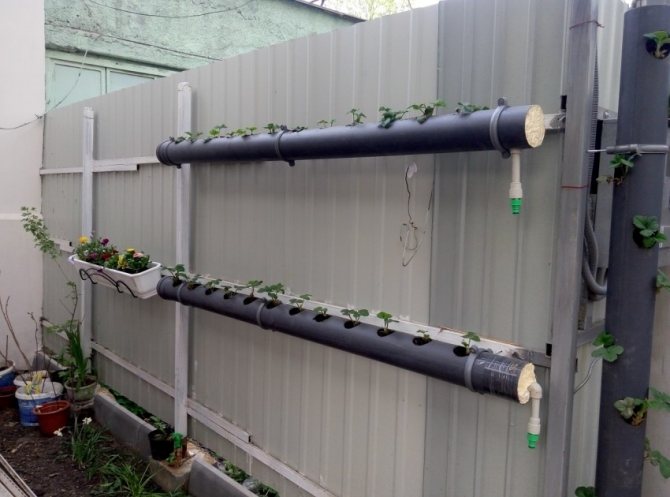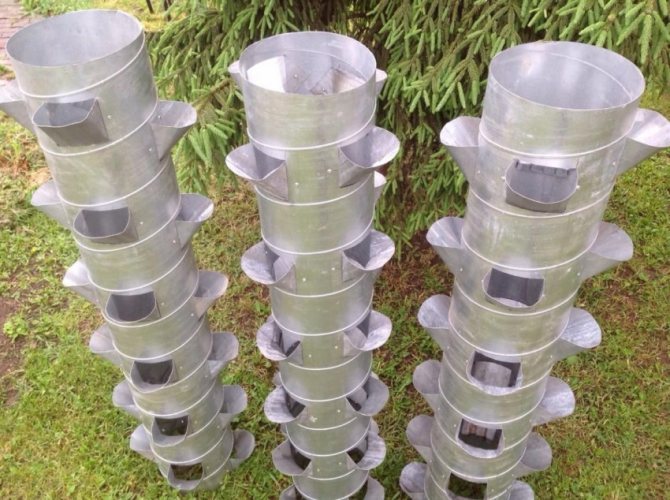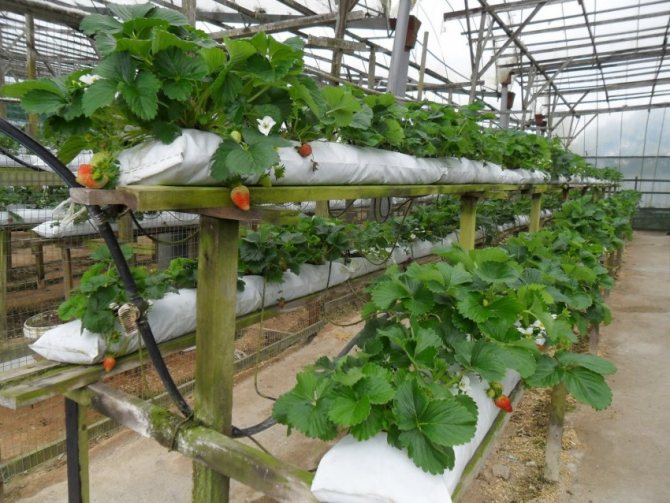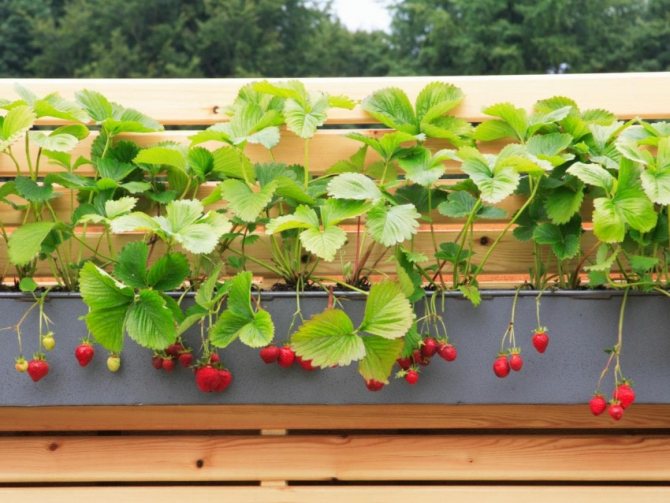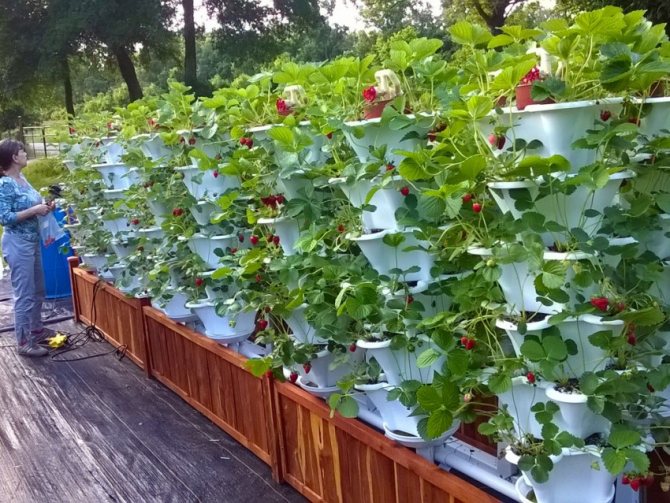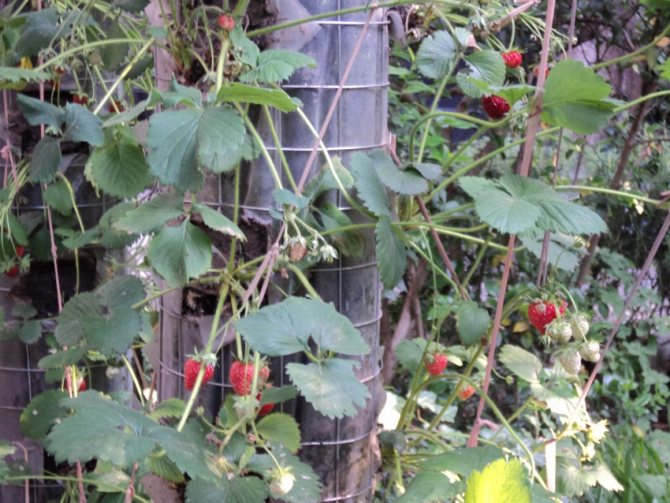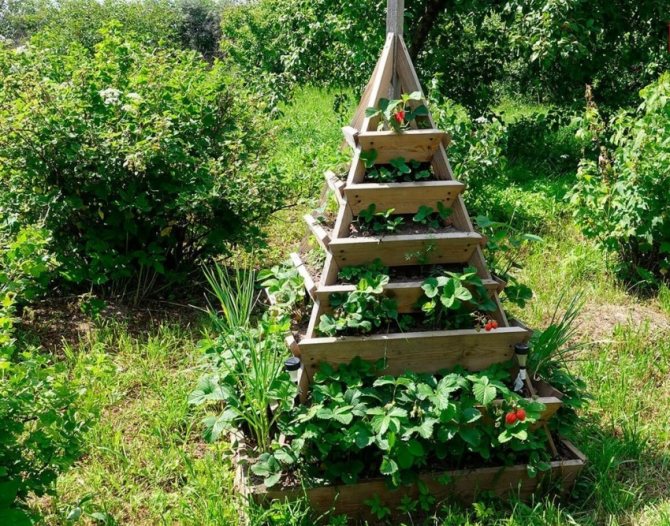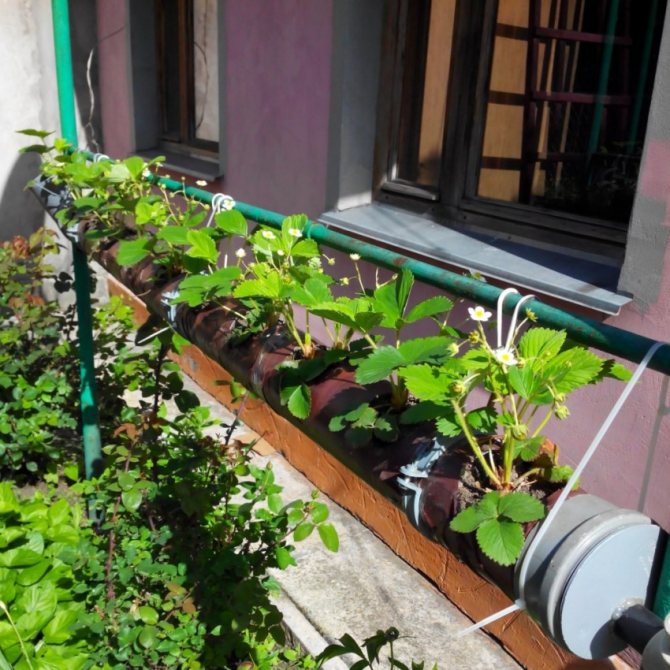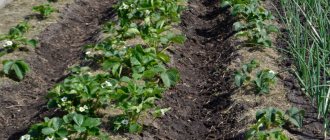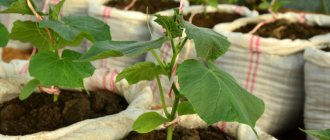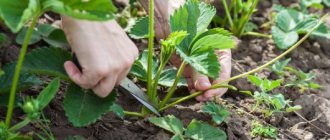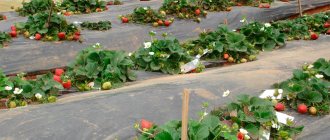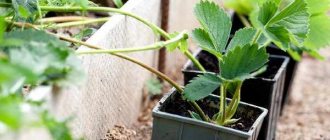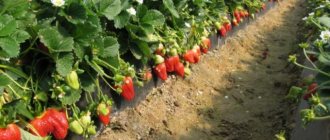There is not a single summer resident who would not grow strawberries on the garden plot. This tasty and healthy berry has been bred in the traditional way for many years, but not so long ago, experienced gardeners discovered an interesting growing method - “strawberries in pipes”. This invention is rational and economical, since the design is compact, does not need additional meters in the garden, and also allows you to get a delicious sweet berry harvest. There is nothing complicated in this method, you just need to figure out the correct use of PVC pipes, find out the varieties of strawberries that are suitable for this method, and get some tips for caring for garden strawberries.
General rules for vertical landing
The requirements for all types of vertical fit are the same. They are much the same as on conventional plantations, but there are some differences.
Recent Entries
11 serious mistakes you make when growing seedlings at home 7 of the best outdoor tomato varieties that will bring you a rich harvest 5 wonderful ampelous plants that will decorate your garden and do not require a lot of hassle
Lighting
Strawberries are located in a well-lit place, the bushes should not shade each other. Although the berry tolerates a little shading - for a short time (for example, in the morning or in the evening) or in diffused shade from a rare crown of a tree. But the more sun and heat, the more sugars in the berry and the better the taste. And in the shade, the berry is sour and small.
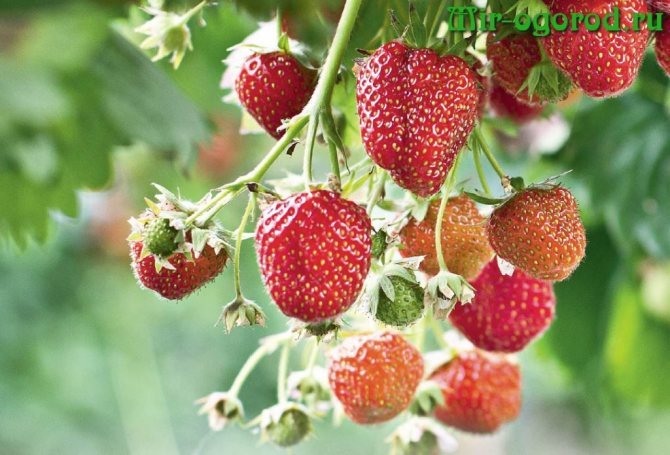
The more sun, the sweeter the strawberries
The required amount of land and watering
Having chosen the type of planting, you need to know the area of nutrition and the volume of soil that is needed for each individual strawberry bush in any vertical type structure. This is about 3-5 liters of soil, or the volume of a pot is 18-20 cm in diameter and 20-25 cm deep - it is at this depth that the main root system of strawberries is located when normally planted on the ground.
In drought, in search of moisture in adult plants, the roots can go to a depth of up to half a meter, and in a limited capacity, the plant is always more dependent on watering than on the ground. In a man-made structure, watering should be provided, as they say, by default.
The volume of soil per bush can be reduced to 2 liters if:
- strawberries are planted for one to two years;
- the soil is formulated correctly, nutritious and balanced, with the addition of vermiculite.
With insufficient nutritional area, the plant will develop and bear fruit, but not at full strength.
Soil characteristics
The soil in the garden lives in natural biogenesis, is replenished with nutrients due to worms, rotted residues, natural bacterial background. The soil for a closed volume is created artificially, so it is extremely important to do it right. Dozens of recipes have been developed, but the main requirements for the soil are as follows:
How to make strawberry beds: examples and tips for arranging
Traditional Russian beds on a flat surface or on an earthen ridge for garden strawberries have significant drawbacks that gardeners no longer want to put up with.
You can often come across the statement that strawberries are a finicky berry. This is not true at allIt does not require frequent watering and feeding, it winters well, reproduces well and can grow in one place for a long time.
All that strawberries need for a high and healthy harvest: oxygen access to the roots without waterlogging, good air circulation in the growth zone of the bushes, an illuminated area, fertile soil and no contact between berries and soil. The correct arrangement of the garden will help to create all these conditions.
Ideal bed parameters and general planting rules
With good agricultural technology, the strawberry plantation lasts up to 5 years. Then the soil accumulates pathogens, is depleted, old bushes bear fruit worse. A site change or soil replacement and plant renewal is required.
Planting stock can be purchased at a gardening store, or you can use the strawberry's natural tendency to blow a whisker to invade new territory. If you take seedlings from your site, then you need to be sure that there are no nematodes and strawberry mites. Disinfection from pathogens is mandatory for both your own and purchased material.
Note! Repaired strawberries give less whiskers, the aisles stay clean longer. If you plan to propagate your variety, then in the second half of summer, pick off flowers, loosen the aisles and conduct moderate watering.
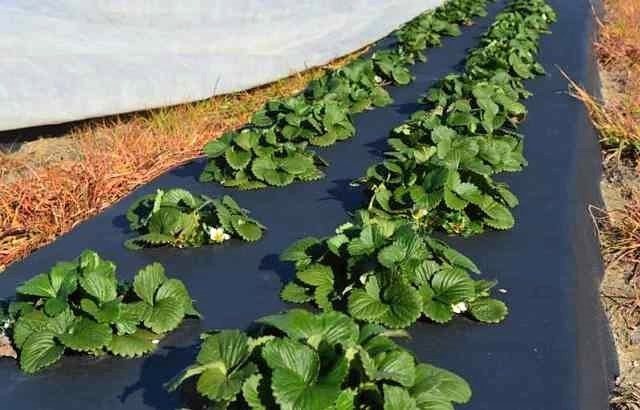

Regardless of the type of bed, we note the parameters that are always taken into account to create an ideal microclimate:
• bed width 80 cm: plants are planted in two rows with a row spacing of 40 cm, the bushes are well ventilated, the row spacing is convenient to weed and loosen, there is no difficulty in picking berries;
• the garden bed is oriented from east to west: uniform illumination throughout the day;
• the distance between plants in a row is 25-30 cm: remontant varieties form more powerful and taller bushes, therefore, the distance for them is increased to 30 cm;
• the optimal distance between individual beds is 65 cm: this is enough for the passage of a garden wheelbarrow to carry out gardening work without hindrance;
• the height of the beds in different technologies is taken from 20 cm to 1 m, but even a slight rise is favorable for the development of culture;
• the soil between the beds is kept in turf (the growing grass is simply mowed at the level of 5 cm): the black soil overheats, and the weeds serve as a breeding ground for pests and diseases, while the low mowed grass is pleasant to the eye and is useful for the garden;
• seedlings are planted under a black film (manufacturers supply them with already cut holes, according to the planting scheme): no weeds, the berry does not come into contact with the soil and remains clean even after rain, as a result, the spread of gray rot is noticeably reduced;
• the neighborhood of strawberries with fruit trees is undesirable: in some years, strawberry bushes may suffer from attacks of leaf-eating caterpillars.
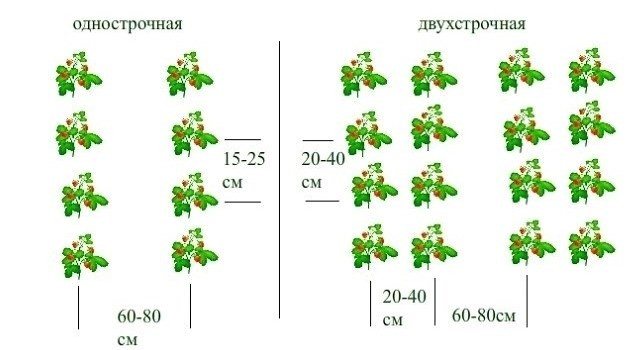

Landing scheme options
In the device of the garden, one should not forget about drainage and nutritious soil. Well filled with organic matter (compost, humus, peat) soil can provide a rich harvest for 3-4 years of cultivation without additional fertilizing. To prevent gray rot, the soil is spilled with Fitosporin solution before planting seedlings.
Tall strawberry bed
Fences can have a height of 20-40 or even 90-100 cm. The second option is more convenient in caring for plants and when harvesting, it is indispensable in swampy areas and with a close occurrence of groundwater with frequent spring flooding. But it also has negative aspects: the soil dries out faster, the plants experience overheating, in severe winters there is a high probability of freezing.
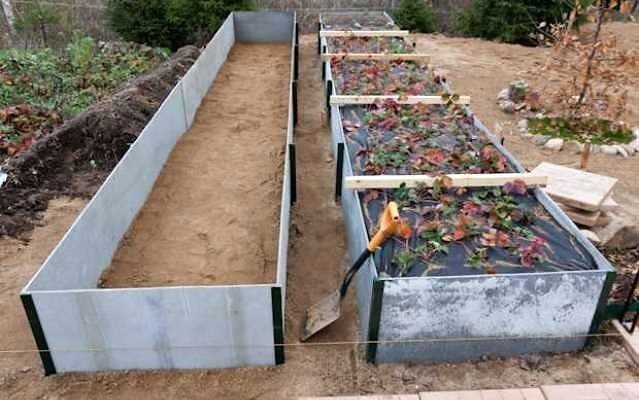

Here, it is necessary to use mulch or black film and winter shelter with spunbond or lutrasil in regions with frosty winters, as well as a drip irrigation device for uniform moisture is desirable.
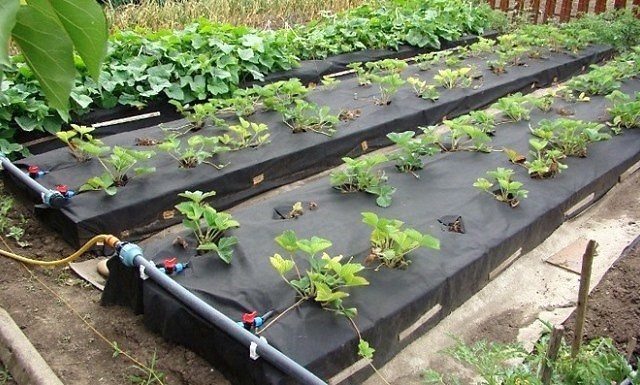

For beds less than 40 cm, weather disasters are not so terrible, but to care for them you will have to bend over and sit down. A box for a garden bed can be made independently from boards, slate, bricks, or you can order ready-made galvanized beds.
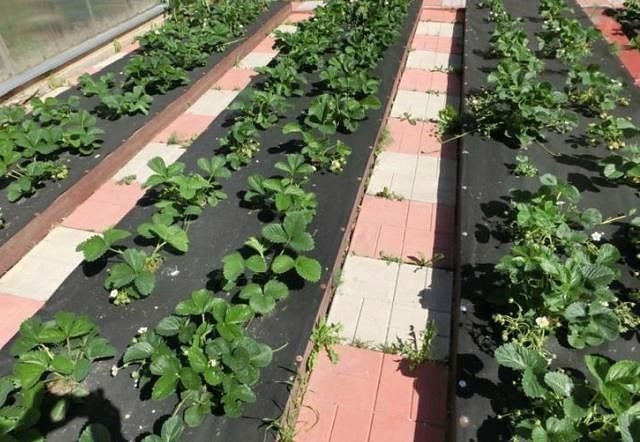

At the place of installation of the box, a layer of earth 10 cm thick is removed.Then a protective mesh from rodents or geotextiles is laid and the box is installed so that its walls are deepened by 10 cm.At the bottom of the bed, large branches and broken bricks are laid out for drainage. At the last stage, the box is filled with nutrient soil from compost, garden soil and poultry droppings.
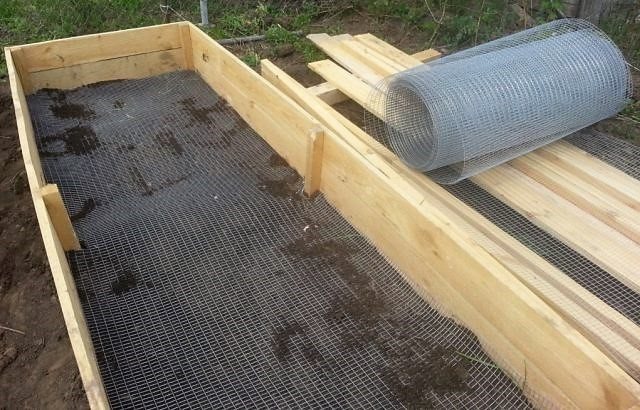

Attention! Do not take land in the beds after nightshades, cabbage and cucumber, as it can be infected with gray rot.
Warm strawberry bed filled with organic matter
The principle of a warm bed is the slow decomposition of organic material with the release of heat. Such a device is suitable for regions with cool summers and late return frosts. The filling of the garden is like a layer cake. The layers are the same as in the compost heap, only in the opposite order.
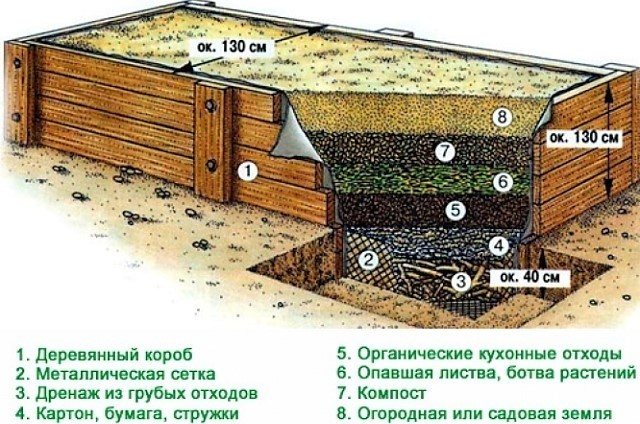

Large wood waste is placed on the bottom: wood chips, thick branches, chopped hemp. Next, pieces of cardboard are lined in several layers. Sawdust and shavings are poured on top, covering everything with a layer of freshly cut grass (great if there are crops of green manure) and chopped weeds (if you are preparing a garden in the summer, make sure there are no seeds).
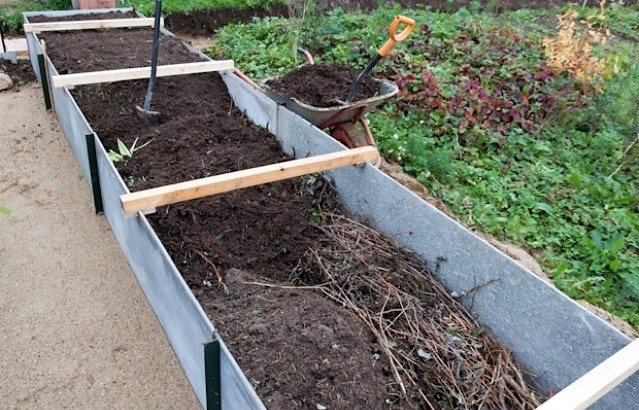

The last layer is matured humus or compost. The root system of strawberries is fibrous and highly branched. The bulk of the roots is in the 20-25 cm layer. This must be taken into account when determining the thickness of the fertile layer.
The average height of a warm bed is about 1 m. If you want to "lower" the fence, before installing and filling the box, dig a pit of the required depth.
Vertical bed from the pipe: closer to the sun
The idea of vertical beds tempts by saving space in the garden and decorativeness. This option is suitable for areas with any soil, and the garden bed itself can be placed right in the recreation area and enjoy the aroma and taste of ripening berries while lying in a hammock. Still, this technology is good for a humid and mild maritime climate, and not for the arid Volga region or the harsh Moscow region.
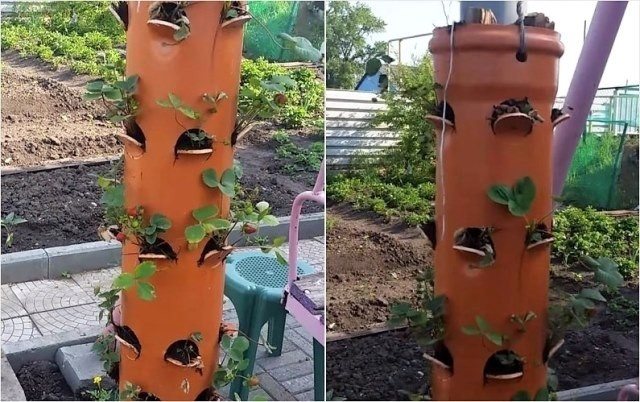

A small volume of potting soil dries quickly, therefore an integrated semi-automatic irrigation system is required. To increase the moisture content, a hydrogel is added to the substrate.
The process of making a vertical bed from a plastic pipe includes the following steps:
• cut holes with a diameter of 10 cm in the pipe of the required length;
• the first bottom hole is located 80 cm from the edge (this part of the pipe will be buried in the soil)
• in the lower part we put a plug with drainage holes;
• an irrigation pipe with holes wrapped in agrofibre or burlap, or a drip irrigation tape, is installed in the cylinder in the center;
• the pipe is filled with a substrate simultaneously with the planting of seedlings;
• plants can overheat, so it is advisable to cover the plantings with white spanbond.
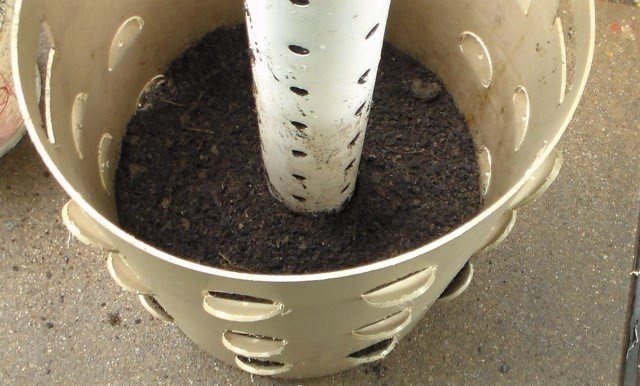

For the winter, vertical structures in Central Russia are either transferred to a horizontal position and thoroughly covered, or brought into a closed room.
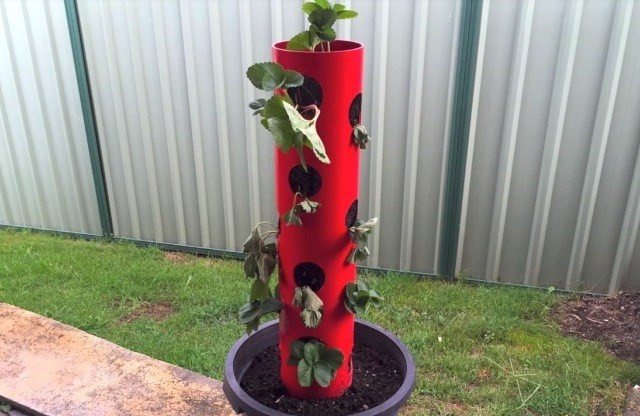

Another nuance of a vertical plantation: it is impossible to collect planting material from it to renew plantings. Therefore, in order to preserve the collection of varieties, we recommend leaving a few bushes in a traditional garden bed.
Interesting options for do-it-yourself strawberry beds
In this section, we will look at ideas for mobile beds that can be placed in any sunny part of the site. They can be made from cheap materials at hand. In order for the plants to develop and bear fruit, the structures are filled with a substrate enriched with organic matter.During the growing season, feeding with an ash solution, infusion of bird droppings or mineral fertilizers is mandatory. To increase the water-holding capacity, a hydrogel is added to the soil.
Even with proper care, mobile beds are short-lived. Full soil replacement every 2 years will allow keeping the yield at a high level.
A bed of plastic bottles
For the full development of a strawberry bush, a volume of at least 2 liters is required. Cut off the neck of the bottles, but do not throw it away. We will make a drainage device from it: remove the lid and lower the resulting funnel to the bottom of the bottle, wrapping it with a thick layer of burlap or agrofibre; at the bottom of the bottle, stepping back 5 cm, we make round holes for drainage and evaporation of excess moisture with a diameter of 5 cm.
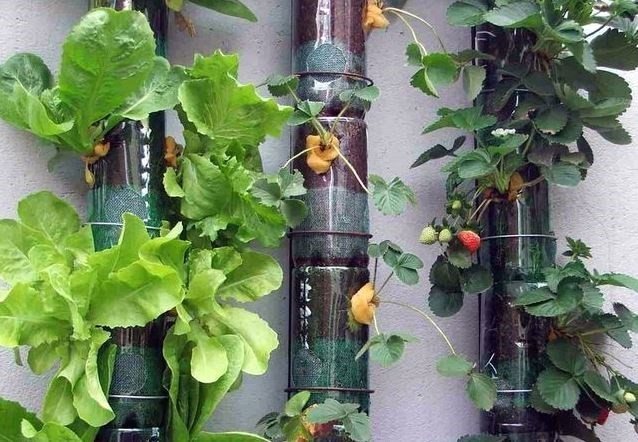

To ensure systemic irrigation in the bottom of each bottle, we make several holes through which water will flow from the upper bottle to the lower one. Do not make a bed too high, a chain of 4-5 bottles is enough.
We plant the seedlings in a hole with a diameter of 5-8 cm. Place the bottles on top of each other, securely fixing them with wire to the wooden frame.
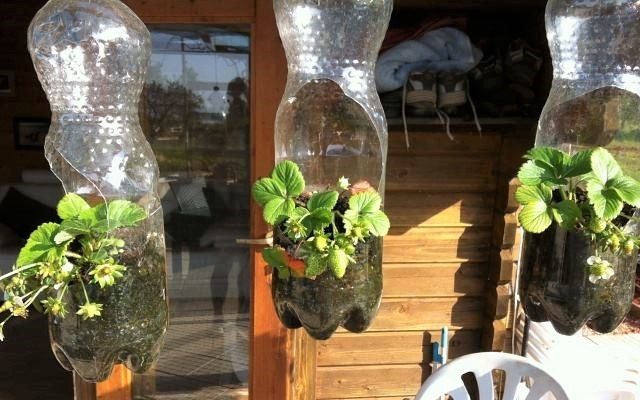

This option is well suited for creating a one-year ornamental garden. It can be placed near the playground so that children can feast on clean berries and do not spoil the main beds.
Horizontal bed made of PVC pipes
The essence of the idea is as follows: holes with a diameter of 10-15 cm are made in a large-diameter pipe at a distance of 15-20 cm from each other, filled with nutrient soil and installed on high supports. Drainage - small pebbles.
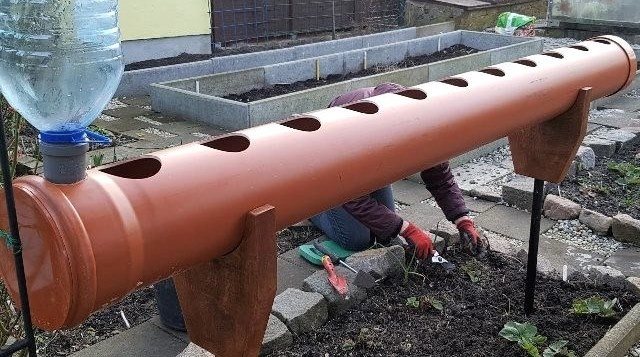

Watering is carried out through an inner pipe with a diameter of 40-50 mm with holes; for even distribution of water, the pipe is wrapped with a covering material. A more effective but costly method is drip irrigation.
A bed of old car tires
Not the most environmentally friendly option, but actively used. You can create a column by stacking tires of the same diameter on top of each other. Or make a pyramid using tires of different diameters. Let's consider the first method, since it has some nuances.
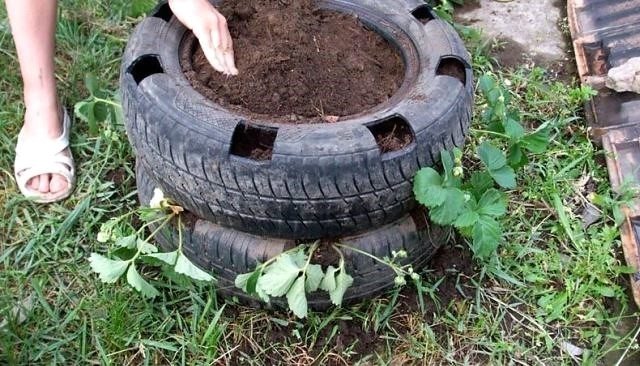

In the upper part, we cut out square holes of 10x10 cm, we make an interval of 15 cm between the holes. We must not forget about the drainage. At the installation site of the bed-column, you need to dig a shallow 7-10 cm foundation pit and fill it with sand and gravel. In the lower part, in the circle of each tire, make holes with a drill for water drainage.
To make the soil sufficiently loose and breathable, we add peat and perlite.
Strawberries in hanging bags
This is a great cultivation option for a balcony, terrace or gazebo. It should also be considered as an addition to stationary beds. Seedlings are planted in bags with pockets or in separate small bags. You can sew them yourself from thick fabric or buy ready-made ones at a gardening store.


There is no need to think over drainage here, since the water itself will drain through the burlap. Plant care includes frequent and not abundant watering, top dressing and evening spraying of the leaves.
Wooden strawberry pyramids
Eco-friendly and durable beds can be made from wooden planks. First, several boxes with different perimeters are knocked down so that it turns out to assemble a pyramid.


Then the structure is covered with nutritious soil and the seedlings are planted. Low sheltered pyramids withstand Russian winters well.
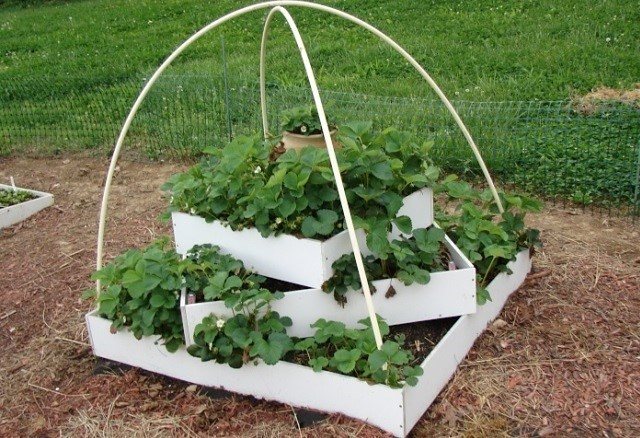

Garden bed made of blocks
Among the materials at hand in the country, there are very often various building blocks that can be perfectly used for organizing beds and flower beds. A hollow block offers more options than a standard solid or fence-only brick.
Like the elements of the constructor, such blocks are folded into various structures, and their voids are filled with strawberry bushes.
A source
The best varieties
In vertical beds, it is recommended to grow remontant strawberries and strawberries of neutral daylight hours, since these types of berry crops bear fruit continuously. Good results are also shown by ampelous strawberries, which tie berries on the tendrils that have not yet rooted.
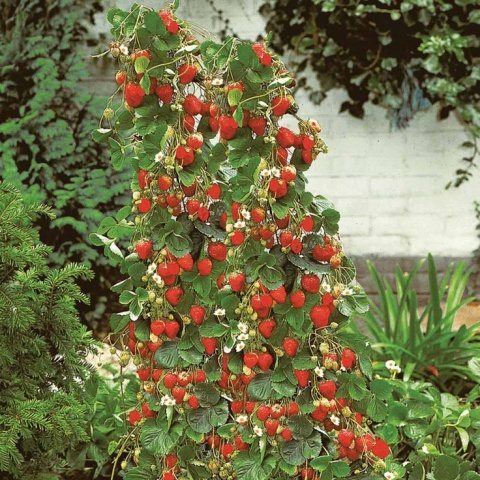

The main rule when choosing - the strawberry variety should be high-yielding. Typically, these species form a lush green mass and a large number of fruits. Such plants will not only delight the gardener with a rich harvest of delicious berries, but also decorate the site.
Important! Seedlings must be of high quality, otherwise most of the bushes will not take root and will have to be replanted.
Shelter for the winter
It is not enough to make beds for strawberries and plant seedlings, you need to take care of the shelter of the plantings for the winter. When the temperature is below freezing for a week, it's time to prepare the strawberries for winter. In the southern regions, strawberries are covered with mulch, it can be straw or sawdust. In the middle lane, spruce branches, needles and agrofibre can serve as a covering material. Best of all, garden strawberries overwinter under a large layer of snow. After three to five years, the strawberry bushes will need to be transferred to a new site, and after it, green manure crops will need to be planted: legumes, cereals, cruciferous, aster. They enrich the soil depleted with strawberries and improve its quality.
A variety of types of strawberry beds - from trench and bulk to vertical - makes it possible to use the available plot as efficiently as possible and harvest a rich harvest even from a small area. Unusual designs of strawberry beds will become a real decoration of the garden plot.
Pros and cons
Pros:
- significant space savings;
- the ability to create ideal conditions for growth and get high yields;
- ease of care, comfortable ergonomics of work - no need to bend over;
- berries do not touch the ground, do not rot and are always clean;
- no weeds and slugs.
Minuses:
- great dependence on artificial irrigation, top dressing and the quality of the prepared soil;
- immediately you need to provide for the upcoming wintering of plants. Planters and pots, wooden boxes, small removable pipes can be brought into outbuildings. In the greenhouse, they spend the winter without problems. But bulky and heavy structures will either have to be sheltered for the winter, or every year new seedlings of those varieties that can bear fruit in the first year should be planted.
Disembarkation and leaving
When the structure is ready, prepared young bushes can be planted in it. Before starting work, choose healthy strong seedlings, the roots of which are moistened in a mixture of clay and manure. This treatment helps the plant retain moisture. The roots are planted in the ground, in the prepared grooves, while the roots are handled carefully, without bending or breaking. The neck of the root system should be at ground level.
Marigolds must be planted between the strawberries or at the bottom of the structure, depending on the location methods. These flowers repel various harmful insects.
The planting scheme is original, not every planting hole is planted with a plant. The planting method makes it possible to rejuvenate and renew strawberry bushes, root shoots.
Suitable soil
Suitable for planting soil, purchased in the store, and homemade. The soil laid between two plastic products should be light, soddy with the addition of peat.
You cannot use the soil in which the tomatoes grew for planting strawberries.
The structure of the soil can be improved by adding sand and sawdust, foam balls to it. Wood ash added to the planting soil will help save the root system from decay. Garden strawberries love acidified soil, so they need to be watered with vinegar solution.
The drainage layer is 2-3 cm. After filling each hole with soil, the drainage is filled up. Such an earthen mixture is depleted, due to the fact that it lacks natural elements coming from the soil layer. Fertilizers and top dressing are required in this method.
Crushed expanded clay, moisturizes the plants for a long time, and the roots feel good.
There are no special rules for caring for garden strawberries in pipes. All activities include timely watering, feeding and protection from disease.
Nutrition and hydration
This method is designed for good and frequent watering, as the soil in the pipes dries up quickly enough. It is necessary to control the moisture content according to the condition of the soil in the holes. Water is poured into the smaller pipe, filling to the very top (vertical arrangement). After that, the water releases moisture to the plants. But excessive moisture leads to the appearance and spread of fungal infections.
If the gardener or gardener has little free time, an autonomous irrigation system is installed on the beds of PVC pipes. Strawberries are ideal for drip irrigation.
The process of feeding garden strawberries grown in pipes differs significantly from a culture grown traditionally, especially fertilizers and growth stimulants are needed:
- plants need frequent feeding, as the soil is depleted;
- fertilize strawberries at least once a week;
- liquid fertilizing is used, combined with moistening, the solution with nutrition is poured through an irrigation pipe, it gets to the roots of the plant;
- dressing is prepared from organic fertilizers by dilution with water, in the appropriate proportion, sometimes they use ready-made complex fertilizers.
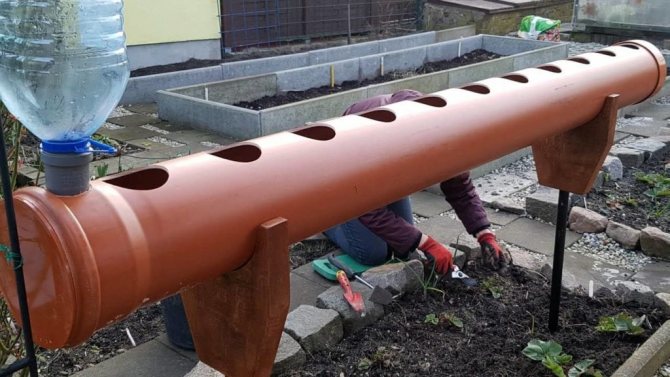

Dangers
Strawberries grown using this method are much less likely to be attacked by various pests than those grown in the traditional way.
Good light and regular watering will prevent slugs and snails from spreading, but sometimes the plant is attacked:
- Colorado beetle;
- weevil;
- strawberry mite;
- whitefly.
If insects appear, then the seedlings must be treated with "metaldehyde", following the instructions in the instructions. "Karbofos" in solution will help get rid of ticks and other pests. If the plant is attacked by Colorado beetles or May beetles, they must be harvested by hand, fertilizers are not suitable for ripening berries, they have a long duration.
Types and their features
The size and type of the garden bed is important for yield indicators. In the traditional way, garden strawberries grow in carpet, nests or rows. A similar landing pattern is suitable for high areas. The owners who appear at the dacha on weekends use the carpet method, thanks to which the cultivated plant multiplies and creates a special climate - a layer of mulch is formed on the surface of the soil. This provides moisture and nutrition for the strawberries. However, one significant drawback in this option is that when a large number of outlets appear, the berries become smaller.
Modern gardeners have come up with, and in practice have tested other ways of planting strawberries, which consist in creating different types of beds:
- low;
- high;
- vertical;
- from improvised means.
Each type of garden bed has its own advantages and disadvantages. A common advantage of all types is simplicity; any gardener who knows how to hold a tool in his hands and who is familiar with simple recommendations can make a bed of different types.
Strawberries from above
For the first time, the type of bed was developed by gardeners from Germany. The essence of the method is to plant seedlings in boxes or boxes filled with soil with fertilizers. The fences reach a height of one meter, which is especially comfortable when looking after plants and harvesting. The option is suitable for wetlands, and with the occurrence of waters in the ground, with spring thaw.
The advantages of this type of landing are as follows:
- weed control;
- simple construction;
- suitable for shaded areas;
- there is no need for weeding the aisle;
- creation of level beds.
To plant strawberries in such a bed, you need to follow step-by-step steps:
- Choose the optimal landing position.
- Mark the stripes.
- Make boxes from wood or metal material.
- Dig a trench no deeper than 40 cm.
- Place the manufactured installation in it.
- Lay organic matter on the bottom - grass, sawdust, branches. This contributes to the fertility of the soil.
- Stepping back 5 cm from above, fill the earth with fertilizer.
- Make holes, place strawberry seedlings in them. Leave the core of the bush at ground level.
- Water the bush under the root.
Sometimes sheet material is taken to construct the box. It is laid on the bottom, and the walls are made of wooden planks. Such material will be fiberboard, plywood and others. Boxes are simple and multi-tiered.
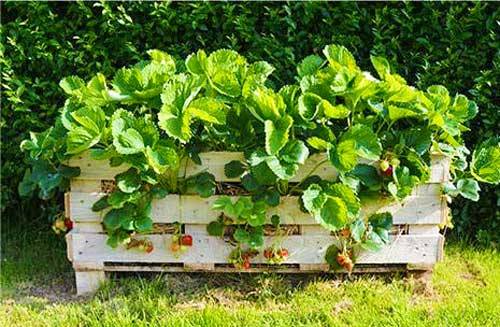

Planting seedlings in high ridges saves berries from the attack of various bacteria and weeds. This method is used on any type of land. The box creates an internal environment for the growth of the root system. Moisture stays inside for a long time, you can add the necessary additives at any time. It is not necessary to cover the plant with this method. The negative aspects of the method of high beds consist in the rapid drying of the soil, overheating of the plantings, and in frosty winters there is a high probability of freezing.
Low beds with shelter
For such a system, boxes are also made, but of a slightly different plan. Bumpers made of wood divide the stripes with strawberries in the garden, and work like furrows. The principle of the method consists in the formation of a bed with one strip of strawberries, fenced with boards. The planting can consist of one row or two rows of strawberries.
Preparing a bed for strawberries with a low design is accompanied by the same steps as when creating high boxes. When the bushes are completely planted, paths of stone or tiles are laid on the plots for ease of movement.
The advantages of this method are as follows:
- Fencing has a positive effect on the harvest.
- Plant maintenance is made easier.
- The soil is not washed out during the rains.
- There are no weeds.
- The sides prevent the long mustache from intertwining.
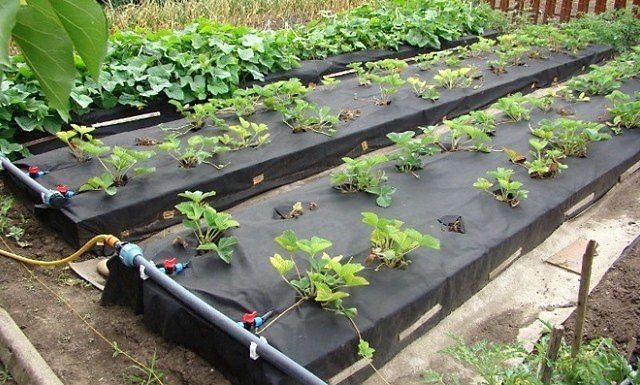

Watering is carried out in circular motions, without eroding the soil near the bush, so as not to expose the roots. Plants are watered strictly under the roots. In this method, mulch or black film is used, and for winter, a spunbond cover is used.
Column beds
The idea of vertical structures is original and rational, it saves space in the garden area. In addition, this type is an additional decor to the design of the backyard area. This is a universal type for which any soil is suitable, and the garden bed is located in the area you like, around the buildings.
This method is good for humid and mild climates, the soil dries quickly and requires moisture. Vertical beds consist of several PVC pipes of different diameters and lengths.
The principle of manufacturing such a structure is as follows:
- Holes are drilled in a larger tube, where bushes are planted.
- The lower part of the pipe with a plug is buried in the ground.
- A smaller irrigation tube with pre-drilled holes is installed inside this pipe.
- The inner cylinder must be wrapped in burlap or other special material.
- The space between the pipes is filled with soil.
- Strawberry seedlings are planted in the substrate.
- To avoid heating, the plantings are covered with spunbond.
During wintering, vertical structures are turned over to a horizontal position or removed to covered rooms.
Plant varieties
Breeding strawberries in PVC plastic pipes is an exciting and profitable activity.For planting seedlings in installations with vertical or horizontal pipes, you need to carefully select the appropriate variety. Not every variety is suitable for the pipe method. Plants of remontant species are used, which ripen several times a season.
The following strawberry varieties are recommended:
- Albion;
- Homemade delicacy;
- Gigantella;
- Yellow Miracle;
- Temptation;
- Diamond.
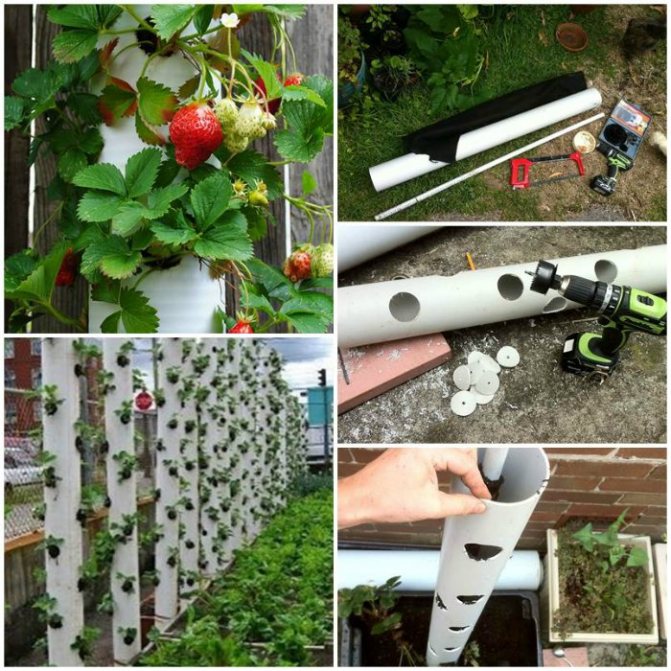

These species will provide early ripening of fruits, resistance to pests, and a one-year harvest. In plastic pipes, ampel varieties are grown, which are a kind of garden strawberry, with a long mustache. In the formed rosettes, berries are formed, and even without rooting. In addition to a bountiful harvest, such species are distinguished by their external properties. Strawberry bushes look like a cascade of shoots and foliage, strewn with bright berries and inflorescences.
Vertical bed of boxes
Boxes of equal length are hammered from the boards. The optimum difference between the width of the structural elements is 30 cm. In order to arrange the cultivation of strawberries in a vertical way, the boxes are placed in the center of each other or trimmed in the back wall. It is best to make a bed of boxes 2.5–3 m long with a lower box width of 1 m.
After erection, the containers are filled with loose soil mixture, watered and planted with strawberries.
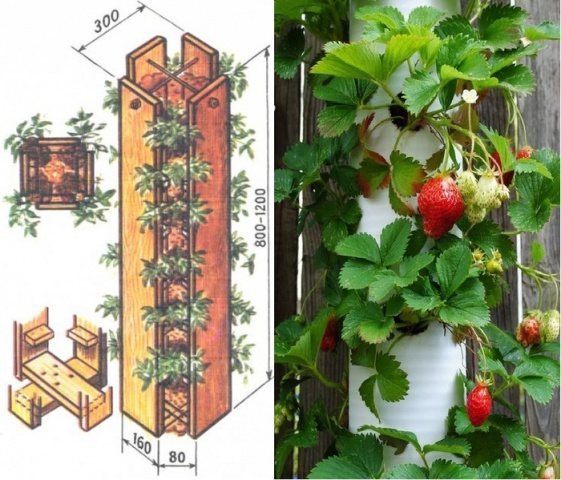

You can also make a garden from square boxes. For this, wooden containers are stacked on top of each other in the form of a pyramid. A bed of boxes with a size of 150x90x40 cm looks good.
Varieties and types of strawberries for vertical planting
It is undesirable to plant strawberries in a vertical way that requires a larger volume of soil (varieties with a powerful bush, intensive growth, designed for 3-4 years of growth). Great for pipes and pyramids ampelous bushes of garden strawberries. Experienced gardeners also recommend varieties:
- Queen Elizabeth is a hardy and unpretentious variety that is resistant to many diseases. Fruiting from June to early October. One bush can produce from 1 to 2 kg of berries;
- Alba is an early variety. Winter hardy, fruits are sweet, almost without acidity. Berries tolerate transportation well and are kept fresh better than many other varieties. Can yield up to 1 kg per bush;
- Homemade delicacy F1 is a remontant ampelous variety. Berries with sourness, rather large, up to 3 cm in diameter. Long stalks are located close to each other, which is why the berries hang tightly, which looks very beautiful.
Photo gallery: strawberry varieties for vertical cultivation
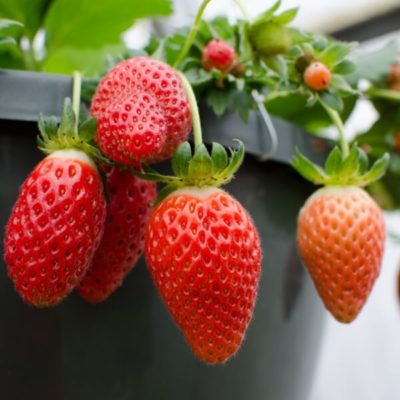

Strawberry variety Queen Elizabeth - hardy and unpretentious
Strawberry bed size
Serious influence on the final result of cultivation has interval between landings. Strawberries placed on the ground cover the area with a carpet, thereby creating its own microclimate. Further growth negatively affects the size of the berries - they become smaller and lose their taste.
To obtain large fruits, you must adhere to the following parameters:
- The standard bed width is within 80 cm - two rows of strawberries are placed in it with an interval of 40 cm. A too wide area creates problems with watering, weeding and harvesting.
- The disembarkation should be located from the east to the west. This will prevent the bushes from casting a shadow.
- The height of the bed is selected based on the type of construction applied:
- 1. Low boards have a height of 20-40 cm. The advantage is ease of manufacture.
- 2. Tall ones have a side up to 90 cm high. This design simplifies berry care.
- The width of the furrow for planting is 30-40 cm, and its depth is at least 20 cm.
- The distance to the nearest strawberry bush is 40 cm.
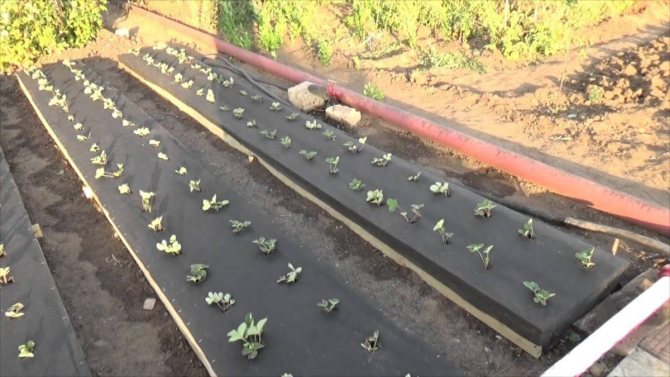

The following landing schemes will help you better understand the distance:
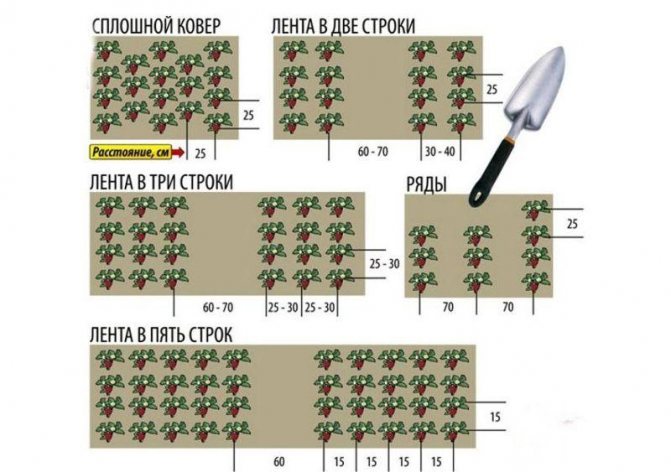

Strawberries in bags
Perhaps the most affordable and simple vertical bed. A loop is sewn to the top of the bag made of dense natural fabric. Holes are made at intervals of 20 cm.The bag is hung on a fence or wall, a narrow tube with holes is inserted inside and covered with soil. To prevent the material from tearing under the weight of the soil, the side seams are sewn 2 times.
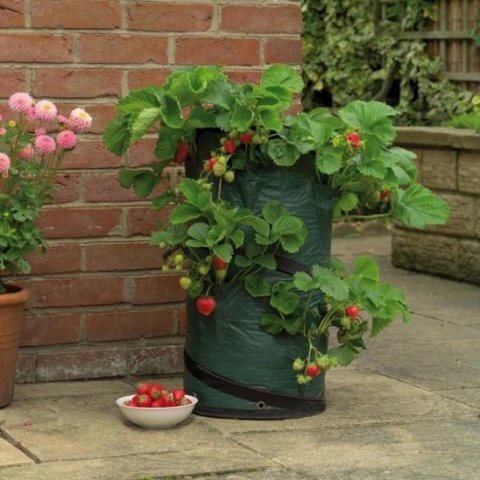

The second option for a hanging bed is pockets. The planting organizer is sewn from burlap or dense natural material.
Method number 2
The next way to make vertical beds for strawberries from bottles: twist the cork in a two-liter bottle and cut a hole from one side, fill it with prepared earth, make a depression and place a bush. A mesh is built and a container is attached with a wire along the edges, an eggplant is nailed to a wooden structure. The plant must be immediately watered with settled water.
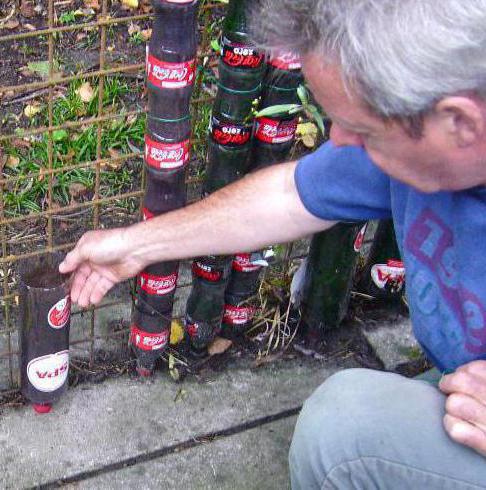

Gardener's secrets: vertical beds, and what materials to make them from
A vertical bed is a planting of plants so that they hang freely or grow in the form of a pyramid. To create such beds are used:
- Cache-pot.
- Downpipes.
- Old tires from cars.
Advice! From a decoratively cut plastic bottle, you can also create a vertical bed, greening any surface.
- Unclaimed pallets or plastic containers.
- Clean plastic bags.
For hostesses, a vertical bed is simply ideal, because weeds and fewer pests do not grow in it. The harvest that a gardener receives from a vertical bed, of course, cannot be compared with mass plantings. A vertical strawberry bed rather carries a decorative function, and its creation should be approached with love.
Tire pyramid
It is quick and easy to build such a bed. All that is needed to arrange a landing site is several tires of different diameters and a tool for making holes. The optimum diameter of the nests is 10–20 cm. Starting with the largest one, the perforated tires are folded in a column, gradually covered with a substrate with the addition of humus, and bushes are planted. After planting is complete, the garden bed is watered.
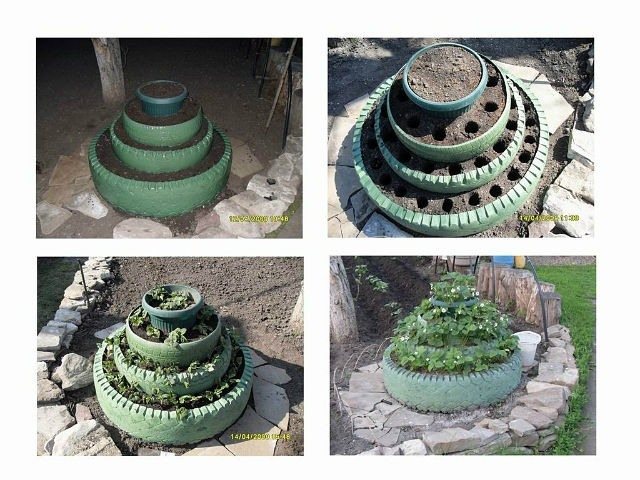

The main advantage of such a bed is that the rubber heats up quickly, as a result of which the plants receive more heat and grow faster.
The same principle is used to construct a pyramid of car disks.
Advantages and disadvantages
Regardless of the type of landing, there are always positive and negative sides. The advantages of the chosen design include:
- Saving space. It is easy to place several vertical or suspended flower beds on 1m2.
- The peculiarity of the location makes it difficult to damage the root system and fruits by rodents or small pests.
- It is convenient to monitor the condition of the soil. Plants will always receive the required amount of moisture, which will exclude drying out or waterlogging.
- Planting care is much more convenient, because everything you need is at hand.
- Cold resistance. With the onset of frost, to preserve the plantings, it is enough just to wrap everything with a covering cloth.
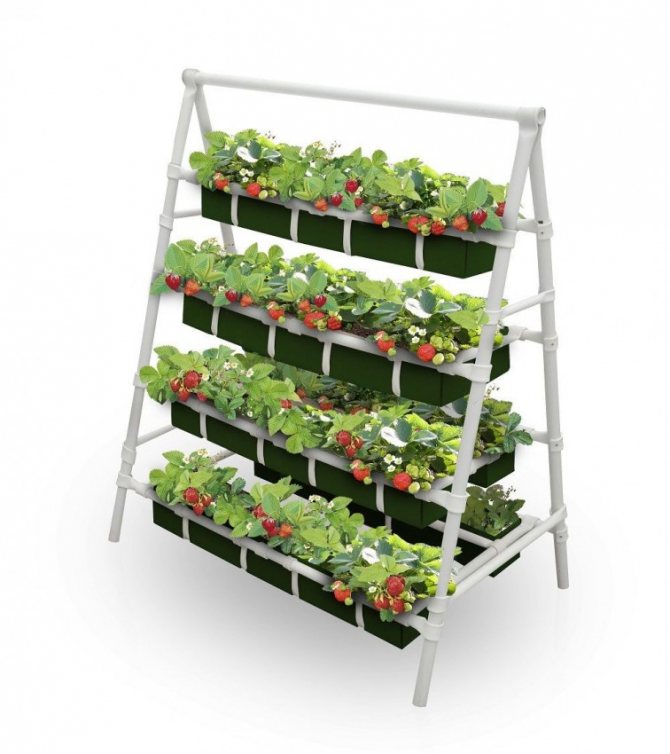

As a result, the system turns out to be the most effective among all the alternatives. Special attention is paid to the need for regular watering and the use of liquid fertilizers.
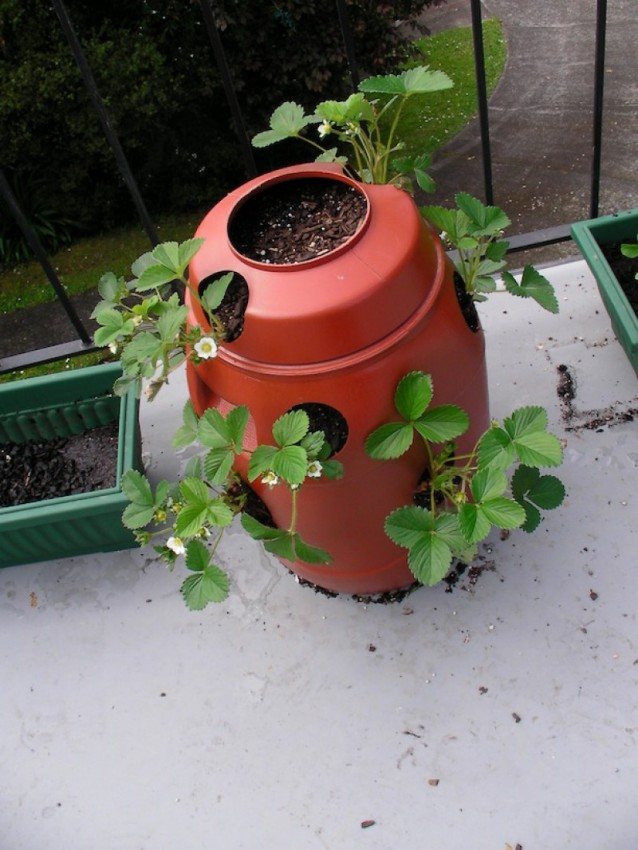

Strawberries in a grid post
Such a bed is also suitable for growing flowers and greenery. To equip the vertical cultivation of strawberries in poles, you need to acquire a mesh of metal rods, film or straw, and a soil mixture.
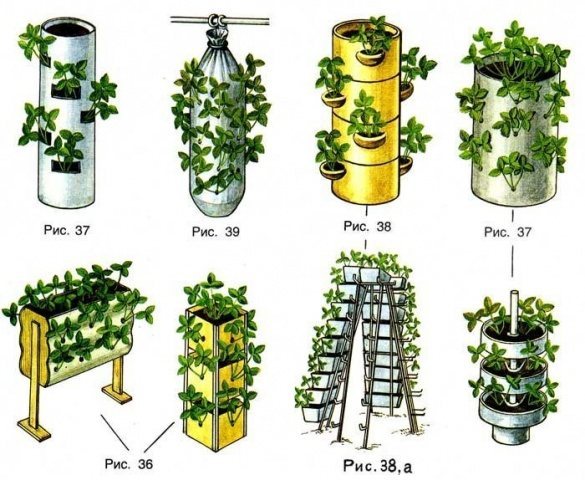

The mesh is twisted into a pipe with a diameter of 90 cm and the ends are fixed with wire. The inner sides of the cylinder are covered with foil or straw, while gradually filling the soil and planting strawberry bushes. After planting each level, the garden bed is watered.
Vertical bed designs
Summer residents are an inventive people, so on the plots you can see a variety of, sometimes unusual, structures for growing strawberries. Most of the designs are made by hand, others are purchased in specialized stores (see.video).
Interesting ideas are collected in our list below.
PVC pipes
One of the most famous methods of planting garden strawberries, characterized by simplicity and convenience. Two pipes of different diameters are selected, one for backfilling the soil, the other for irrigation. Round holes should be made in the walls of the wide pipe for planting bushes, in the watering room - small holes for the passage of water.
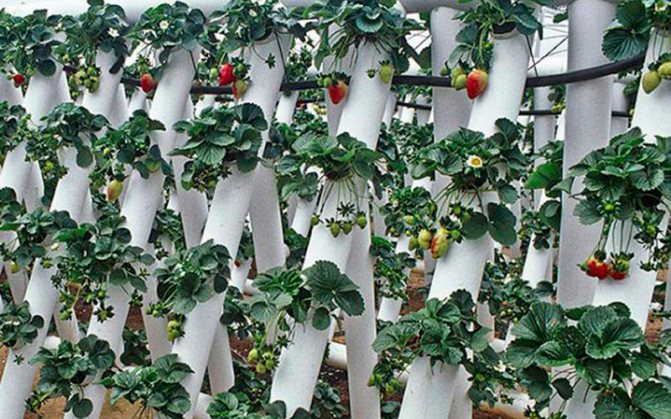

Carefully install a narrow pipe into a wide one, fix it in the center, fix it. Hoses for water supply are supplied. Soil is poured into the space between the pipes and a strawberry bush is gradually planted in each "window". The soil is slightly compacted, spilled with water.
Having planted the plants, the structure is fixed. All that remains is to water and feed the crop, and then harvest. In addition to vertical installation, horizontal installation is practiced - a semblance of tiers is being built.
Multi-tiered structure made of wooden boxes
Outwardly, it resembles a pyramid, while the components can be placed in any shape. Boxes (boxes) with three and five corners are hammered together, placed in tiers, in the form of a pyramid, with a ladder.
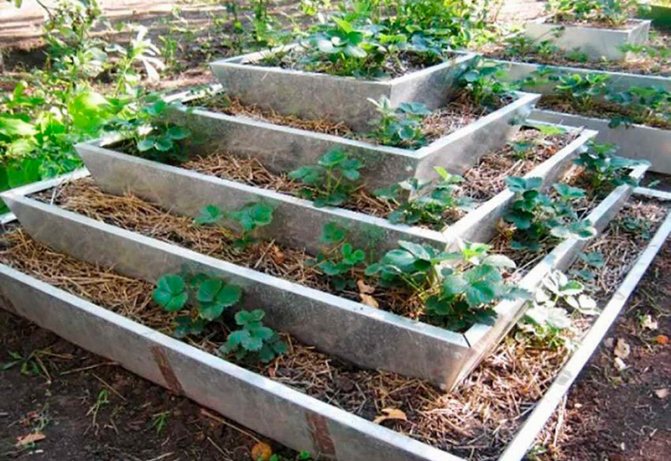

Oak, pine, cedar are suitable, the wood of which is less susceptible to decay. If it is supposed to build a structure like a pyramid, then the boxes are hammered together of the required dimensions.
Then everything is simple: the largest box is installed in the bottom row, and on top, with a ladder, the rest, in accordance with the size. Fertile soil is poured and strawberries are planted.
In bags with pockets
Surprisingly, garden strawberries bear fruit perfectly even in such, at first glance, unpretentious designs. Use tarpaulin or plastic bags, which are sewn into pockets or cuts.
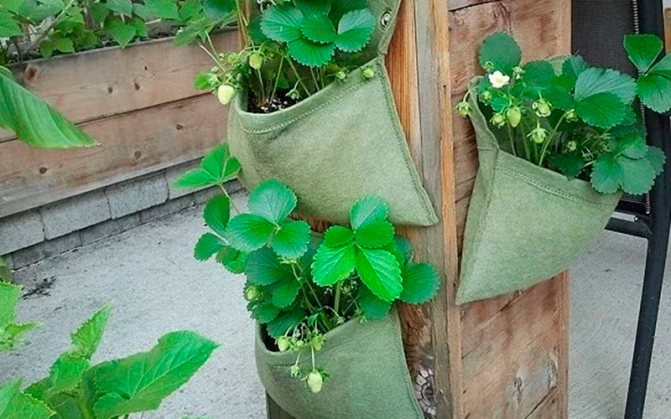

The soil is poured inside, strawberry seedlings are planted, the "bed" is strengthened on the wall of the house, gate, fence. Water it manually or connect hoses to an impromptu bed.
On beds made of PET bottles
Plastic containers are a cheap handy material for the manufacture of structures for planting strawberries. The bottles are mounted on a grid of fences, on a fence (in an upright position), tied up on ropes to a special bar. Holes for plants are cut out in the walls, holes are made in the bottom or cork (depending on how the bottles are placed) to drain moisture.
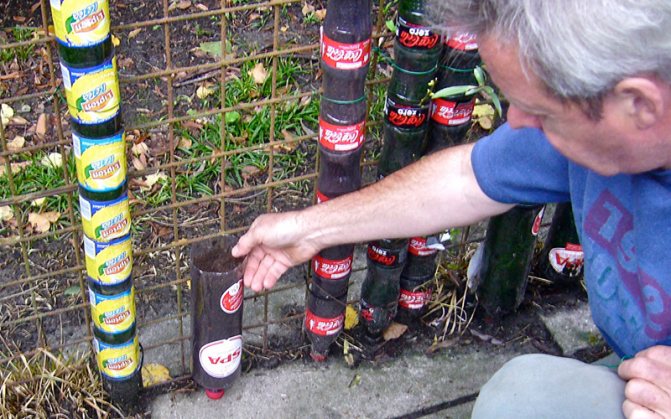

On a note! Bottles with a volume of at least 2 liters are suitable for growing strawberries.
Iron barrels
Horizontal lines are made in the sides of the container, then iron is bent inward under each slot. Get "pockets" in which the bushes will grow.
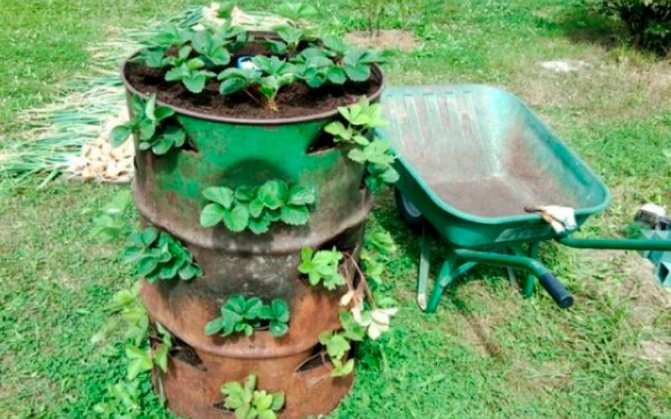

One or more tubes with holes are installed, through which water is supplied for irrigation. The barrel is filled with fertile soil, the plants are planted through the "pockets".
Containers
They are placed in tiers in vertical racks (stacking principle). Install such containers with a ladder, providing the planted plants with a sufficient amount of light.
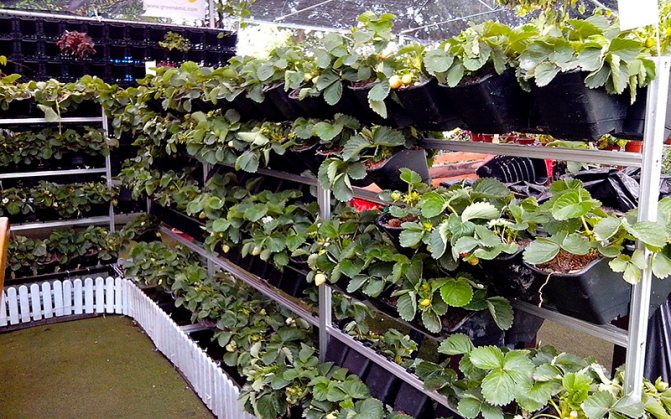

Pots of different sizes
The largest container is placed in the first row, and above, along the steps, another 3-4 pots of a smaller diameter. Get a "pyramid" with strawberries.
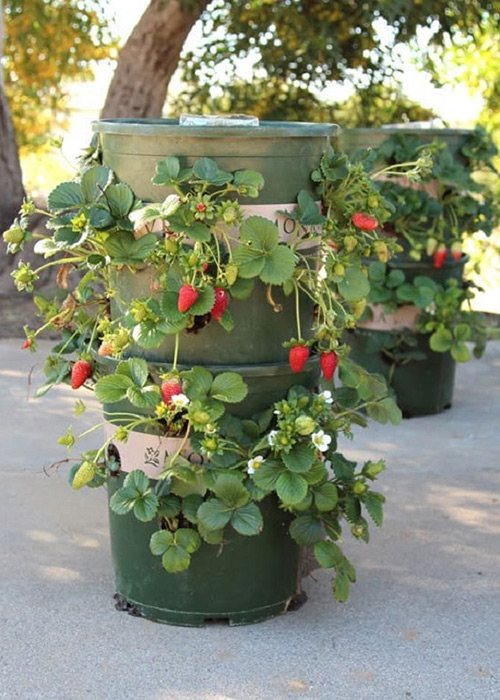

Car tires
Tires of the same diameter are used, constructing a kind of barrel from them, or making a vertical in the form of a cone from different-sized tires. A pipe is installed with side holes and a plug at the bottom. Water is fed into the pipe through the top to irrigate the plants.
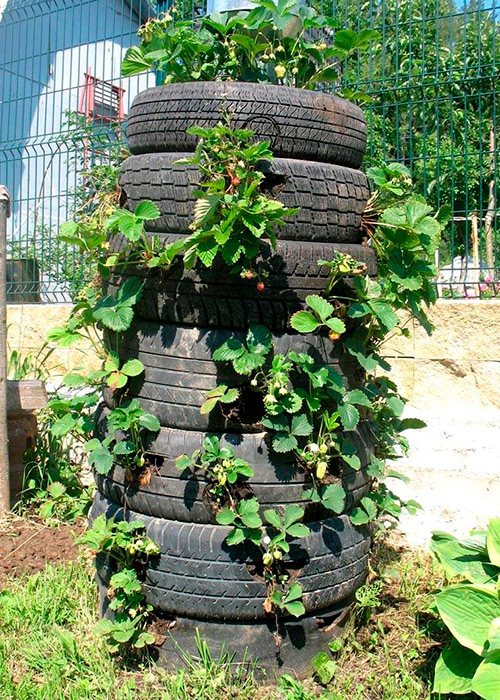

In each tire, holes are made from the sides for bushes. The earth is poured inside, strawberries are planted. Such devices can be seen on the plots of many summer residents, but recently gardeners are abandoning structures made of car tires.
Rubber is believed to emit toxic substances, so it is recommended that tires be replaced with other materials.
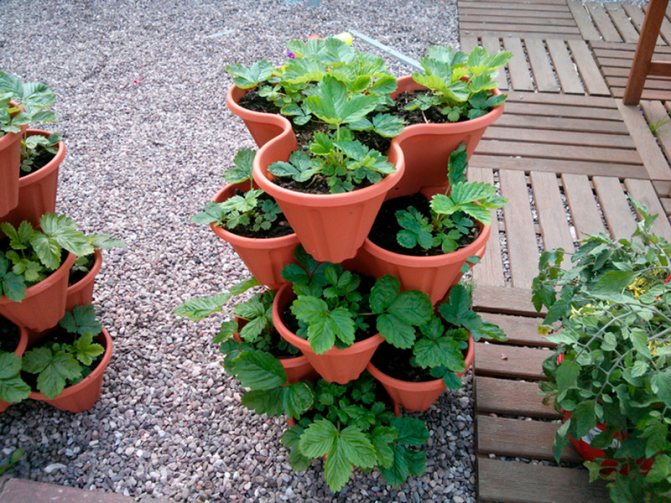

In addition to homemade beds, summer residents are increasingly using factory-made designs.They already have watering systems, holes for strawberries, so all that remains is to choose the right models and start planting.
Placing bushes in beds
The neck of the seedlings should be strong, up to 6 millimeters in circumference, the roots are fibrous, at the bush itself - from three to five green leaves and a bud. If the seedlings cannot be planted quickly, then they need to be dug in the ground and stored for up to 2 days.
If the roots are long, then they are pruned to 10 centimeters.
The roots are dipped in a clay mash - this way the plant takes root in the soil faster, they are placed in cut-out circles and covered with earth.
Make the distance between the bushes up to 10 centimeters and leave up to 1.5 liters in volume for the development of each root. In the pipe, they begin to disembark from the bottom.
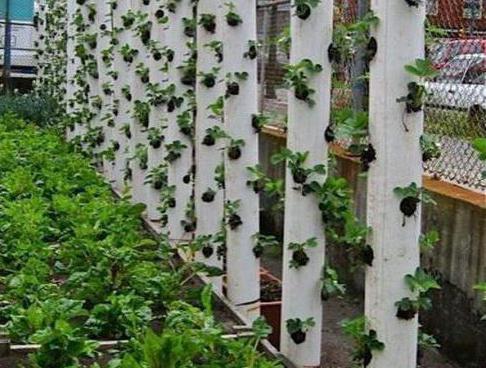

A bed of bottles
Plastic bottles with a volume of 2.5 liters are used as a material for the construction of a vertical bed. There are two types of construction:
- In a sunny place, a grid of metal rods or a board made of boards are installed. The bottom of the containers is cut off, and the lid is screwed in such a way that excess water can flow freely. In the part of the bottle where the bottom was, cut out a petal 5 cm long. The pot is filled with a substrate 1 cm below the petal. Strawberries are planted in the hole and the bottle is attached to the support. The containers are set so that the neck is inside the lower bottle.
- A window is made in a bottle closed with a lid, soil is poured through it and a plant is planted. The strawberry pots are attached to the support.
This method of growing strawberries in a vertical way is not only original, but also generally available, since there are probably a couple of bottles in every home.
Varieties of solutions
Well-chosen designs greatly facilitate the cultivation of berries. In addition, many garden options become an organic continuation of landscape design, acting as decorative elements.
Vertical structures from plastic bottles
This option is the fastest, easiest and most cost effective option. For the construction of a vertical strawberry garden, any number of the most common 2-liter plastic bottles is taken.
Sequence of work:
- Remove labels and rinse plastic containers thoroughly.
- Cut an even rectangle on the side of the bottle, and on the opposite side - a sufficient number of drainage holes.
- In the upper part, stepping back from the neck about 2–2.5 cm, and in the lower, closer to the base of the container, pierce through the hole, through which then stretch a rope or fishing line. At the ends of the rope, it is necessary to tie on a washer or nut to prevent the bottles from falling off and falling under the weight of the soil.
- It is best to use strong wire for horizontal mounting of ready-made modules on the wall.
- Pour a mixture of drainage with soil into plastic containers and plant seedlings of garden strawberries.
When it is planned to plant plants with a small root system in a greenhouse pavilion, then for these purposes you can also make hanging beds from plastic bottles with your own hands. It is enough to cut out a "window" for the seedling in the container, and make a couple of cuts on the sides of the hole to secure the rope. Homemade pots are simply hung by nails to the walls. It will be equally convenient for them to grow flower seedlings and greenery before planting in open ground.
Types of cabbage: characteristics and growing rules
Structures made of PVC or reinforced plastic pipes
The indisputable advantages of using plastic or metal-plastic for arranging vertical beds for plants in open ground or in a greenhouse:
- these materials will definitely not rot;
- they are highly resistant to internal corrosion damage;
- no need to additionally process structures with paint or chemical impregnation: the white surface excludes strong heating.
To create such a composition, a pair of plastic pipes with different thread diameters are taken - 1/2 and 3/4 inches. The preferred length of pipes is 2–2.5 m, this will allow them to be deeply buried in the ground and provide the improvised bed with greater stability.
Sequence of work:
- At one end of the pipe, measure a third of the entire length and put a mark - with this part it will need to be immersed in the ground.
- From the marked place, keeping a distance of 20 cm and adhering to a checkerboard pattern, make a series of round cuts (the optimal diameter is 6-9 cm).
- The lower end of the pipe is dug into the soil and the soil substrate is poured inside it.
- Plants are planted in the holes, and for a strong fixation of the seedlings, they are additionally pressed with small clods of soil.
Irrigation in vertical beds is carried out through the top hole on the principle of drip irrigation. Why before backfilling with earth a thin tube with a smaller diameter is inserted inside the pipe, on the top of which a number of holes are made in advance. With this method of planting, one irrigation system can be equipped with several pipes at once.
Pros of using vertical pipe beds in greenhouses:
- no need to carry out weeding, waste time and effort on endless weed control;
- the indicators of the rate of plant maturation and yield are guaranteed to grow;
- easy to harvest without damaging the stems;
- the root system of green pets is reliably protected from damage by soil pests.
DIY fabric bag constructions
To make a hanging strawberry flower bed, you just need to have basic sewing skills.
Correct preparation of hanging sack beds:
- A dense, durable film is taken, which is covered with greenhouses or greenhouses.
- A couple of rectangles are cut out of the film and stitched securely, turning the corners to prevent soil from spilling out.
- Then the bag is filled with a substrate and cutouts for seedlings are made in a checkerboard pattern. The spreading of the selected strawberry variety will help determine the required distance between the holes.
- The bags are placed on the walls of the greenhouse and watered regularly.
Growing eggplants in a polycarbonate greenhouse
If you don't have the time and desire to sew bags yourself, then by looking at the nearest gardening store, you can easily purchase products made of felt, synthetic fabric or polyethylene, where ready-made cutouts-pockets for plants are already provided.
Pros of "bag" beds:
- the ability to harvest a rich harvest, even if you use a small greenhouse area;
- creating optimal conditions for the growth of strawberries, since the sun will hit the sockets evenly and in sufficient quantities;
The best planting material for this original method of growing berries is considered to be young bushes from last year's strawberry whiskers.
Rack beds
It is convenient to put pots, edged bottles with a plant on racks and hanging shelves. In bad weather conditions, the containers are easily carried to the shelter.
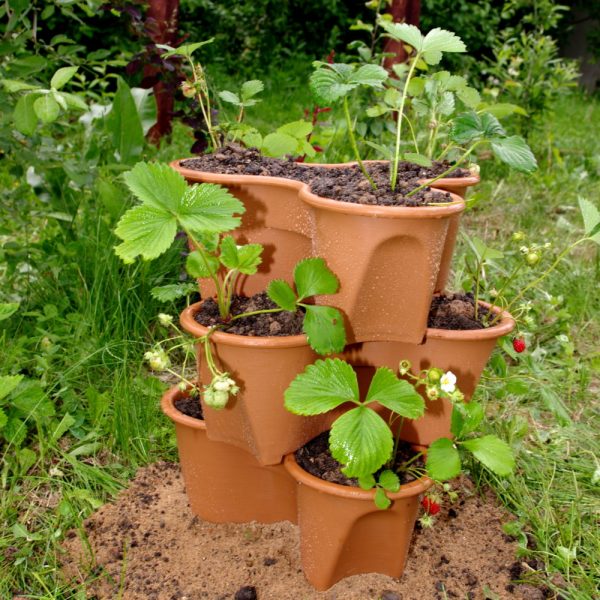

Boxes can be knocked down from the boards and, filling them with earth, can be displayed with matryoshka dolls. Strawberries are planted around the perimeter.
A bed of pots
For the construction of the structure, plastic or ceramic containers are used. The size and shape of the pots depends on the chosen scheme.
- Option 1. Curved ceramic containers are fixed on the dug-in fittings, after giving them a slight slope. Then the soil mixture is poured, the seedlings are planted and watered.
- Option 2. In the bottom of the square pots, holes are made in the center, through which they are strung onto vertically installed fittings. The containers are placed at an angle of 90 degrees. The strawberries are planted in the formed corners.
Now let's look at the care and storage of strawberries.
How to water strawberries
Since the substrate in the pyramid dries out very quickly, you need to carefully consider the irrigation system.The soil should be evenly moistened throughout the structure evenly. For humidification of small and medium-sized containers, tubes are used, which are inserted at the same distance from each other.
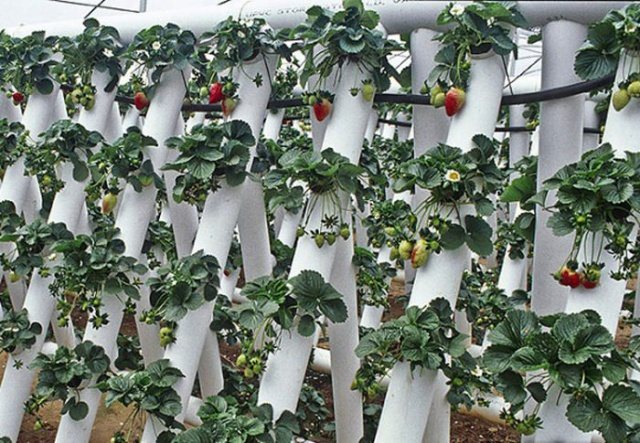

Moisten the soil in the garden with conventional sprayers. An electric pump is used to supply water to plants that are high above the ground.
Storage
So that the containers are not damaged in winter, they are disassembled and stacked in the utility room. If there are none or the structure is too large, the device is laid on the ground and covered with rags, boards or any other materials at hand.
Growing strawberries in vertical beds is a rather painstaking business, but rewarding. If we take into account all the nuances of such a planting, it will be possible to simultaneously collect a generous harvest and give the site an original look.
Similar posts
- Correct cultivation of strawberries in a barrel
- Vertical cultivation of strawberries in plastic bottles
- Growing strawberries using Finnish technology
- How to grow strawberries on a windowsill
- Strawberries on the balcony: growing and care
- How to grow potted strawberries outdoors
- Growing garden strawberries
- How to grow strawberries hydroponically
Original ideas for giving
Advantages of non-standard options for arranging a vegetable garden:
- The vertical bed allows save usable space and prevent the spread of infections and pests;
- High bed with a trellis in the form of an arch reduces the risk of decay of the root system climbing plants and provides good soil drainage... If you wish, you can make a "insulated" front garden with your own hands;
- The main advantages of multi-tiered structures are the ability to accommodate plants in a larger volume and attractive appearance... In addition, you can combine planting of several types of crops and use different soil at each level;
- A mobile mini-garden is the perfect solution to grow a small herb garden. Such a model, equipped with wheels, convenient to move around the territory.
Planting strawberries in the fall: features of care and fertilization
These structures are easy to make with your own hands from worn-out tires, old bags, plastic weirs, remnants of lumber, slate and other improvised materials that are likely to be found in any dacha farm.
Seat selection
First of all, you need to decide on the optimal location of the beds. This takes into account the agrotechnical conditions for growing strawberries:
- The false berry prefers being in the sun. It will yield poor yields in the shade of the trees, in addition, during the spraying of the crown, chemicals will fall on the strawberries.
- The plant must be protected from the wind. It is recommended to place it between the plantings of currants and gooseberries.
- If possible, strawberries are planted in the southeastern part of the garden plot. The area should be flat or on a low rise. It is important to exclude low-lying areas where water accumulates.
- Achieve high yields on sandy and sandy-loamy soil, which is enriched with humus. Strawberries bear poor fruit on calcareous and saline soil with high groundwater levels.
- Ideally, if parsley, radish, corn, carrots, any types of legumes were growing on the site before. At the same time, planting should be abandoned in the area where tomatoes, cucumbers, eggplants, potatoes, and peppers were grown.
